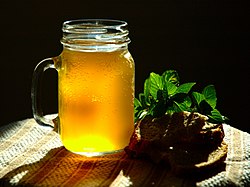User:Altenmann/Kvass
| This user page or section is in a state of significant expansion or restructuring. You are welcome to assist in its construction by editing it as well. If this user page has not been edited in several days, please remove this template. If you are the editor who added this template and you are actively editing, please be sure to replace this template with {{in use}} during the active editing session. Click on the link for template parameters to use.
This page was last edited by AnomieBOT (talk | contribs) 7 years ago. (Update timer) |

Kvass is a traditional Slavic mildly alcoholic sour beverage prepared by fermentation of flour and malt or made from black or regular rye bread ( bread kvass), often with the addition sugar and yeast.[1] The latter one is the most common kind of kvass in modern times, so it is commonly called simply "kvass". It may also be made from fruits, berries honey, etc., and with various additives for taste and aroma.
According to the 2008 Beer Judge Certification Program Style Guidelines, kvass falls into the subcategory of "historical, traditional or indigenous beers" of the "specialty beer" category.[2]
Terminology
[edit]The word "Kvass" derived from Old East Slavic квасъ, kvasŭ, meaning "yeast" or "leaven".[3] Today the words used are almost the same: in Belarusian: квас, kvas; Chinese: 格瓦斯/克瓦斯, géwǎsī/kèwǎsī; Latvian: kvass; Polish kwas chlebowy (bread kvass); Russian: квас, kvas; in Ukrainian: квас/хлібний квас/сирівець, kvas/khlibnyy kvas/syrivets. Except Lithuanian: gira, which means beverage similar to Latvian dzira. In Estonian: kali, which means leaven.
Russia
[edit]

Kvass is mentioned in the Primary Chronicle of Kievan Rus under year of 969.
In the history Russia, a kvass manufacturer or peddler was called kvasnik. Often kvasniks were specialized in particular kinds of kvass: strawberry kvass, apple kvass, etc.[4][5]
Kvass has been considered to be a Russian national folk drink, and the term "kvass patriotism" (ru:Квасной патриотизм) was an ironic reference to Slavophiles and exaggerated Russian patriotism based on "true" folk traditions.
The honey kvass played important role in a number of religious fests among Mordva, rooted in the times of paganism, but later adapted to Christianity. Called purya (пуря) in Moksha dialect and pure (пуре) in Erzya[6], honey kvass was in the names of several traditions: Puresks (pure+ozks, literally, kvass+prayer),[7] Ozim-pure, the celebration of the first harvest, Christianized into a prayer, [8] atayn-pure (атянь пуре) - "honey-kvass of the forefathers". [9]
Lithuania
[edit]In Lithuania, which is historically and culturally close to Slavic lands since the times of the Polish-Lithuanian Commonwealth, kvass is known as "gira", and is widely available in bottles and draft. Many restaurants in Vilnius make their own gira which they sell on the premises. Strictly speaking, gira can be made from anything fermentable — such as caraway tea, beetroot juice, or berries; it can even be made from beer (alaus gira) — but it is made mainly from black bread or barley/rye malt.[10]
According to the official Lithuanian guidelines, a fermented drink may be classified as gira (kvass), if it has no more than 1.2%(volume) of alcohol and no more than 3%(weight) solids. [11]
Culinary uses
[edit]Kvass commonly serves as a base of a number of Russian cold soups.
- Okroshka
- Tyrya, "poor man's soup" bread crumbs thrown in water, kvass, or milk, sometimes with salt or onions.
- Botvinya, made of chopped leaves of beetroot, young nettle, also sorrel, and other leaf vegetables.
- Traditional Romanian sour soups (zeamă)
References
[edit]- ^ Kvass (Russian Fermented Rye Bread Drink) Recipe
- ^ 2008 BJCP Style Guidelines. Category 23 — Specialty Beer
- ^ Etimologicheskyy slovar slovianskikh yazikov (Etymological Dictionary of Slavic Languages), Science Academy of USSR, Moscow, 1987, Volume 13, p 153.
- ^ "Что пили на Руси". Arguments and Facts (in Russian). No. 42. 2001.
- ^ "Квасные посиделки". Arguments and Facts (in Russian). No. 29. 2008.
- ^ [1]
- ^ p. 174
- ^ [2]
- ^ [3]
- ^ [4]
- ^ [5]
